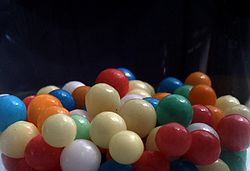


A form of dragée: Liebesperlen ("love pearls")
| |
| Type | Confectionery |
|---|---|
Adragée (/dræˈʒeɪ/ drazh-AY, UK also /ˈdrɑːʒeɪ/ DRAH-zhay, US also /drɑːˈʒeɪ/ drah-ZHAY, French: [dʁaʒe])[a] is a bite-sized confectionery with a hard outer shell.


In their most classic form of dragée and comfit, Jordan almonds, also known as koufeta,[1] consist of almonds which are sugar panned in various pastel colors.[2]
Jordan almonds are often used as wedding favors—like bomboniere—with the "bitter" almonds and the "sweet" sugar symbolizing the bitterness of life and sweetness of love. The treats are often packaged in groups of five to represent happiness, health, longevity, wealth, and fertility.[3] At European weddings, the almonds are placed in groups of five—an odd number that is indivisible—to symbolize the unity of husband and wife.[4] In the Middle East, Jordan almonds are considered an aphrodisiac so there are always plenty on hand for the newlyweds and their guests.[4]
The term Jordan is most likely a corrupted version of the French word jardin, meaning "garden", hence, a cultivated rather than wild almond.[5][6] However, others suggest the term referred to a variety of almonds originally grown along the Jordan River characterized by long, thin, slender, rather smooth kernels in thick, heavy shells.[7]
Jordan almonds are thought to be derived from honey-covered almonds found in Ancient times. According to an unverified legend, it has it that a confectioner named Julius Dragatus served honey-covered almonds called dragati at weddings and births.[4] When sugar became more readily available in the 15th century, the nuts were coated in sugar instead.
Still others believe that Jordan is a corruption of the name of the town of Verdun in the northeast of France. In the 13th century, when the medieval crusaders brought sugar to Europe after their campaigns in the Holy Land, it was very valuable and considered medicinal. During that time, an apothecary in Verdun began coating other medicines with sugar (calling them dragées) to make them easier to take.[4] The town of Verdun became very well known for its dragées de Verdun.
Other chocolate dragées with multi-colored candy shells are M&M's. Initially designed to allow easy transport and consumption of chocolate for the U.S. military, they have evolved into a popular candy, but are also sold as decorative dragées in 25 different colors.
In Portugal sugared almonds ('amêndoas de Páscoa') are the most traditional treat and gift rather than chocolate eggs. Entire aisles in supermarkets may be devoted to them in the run-up to Easter itself.
Used to increase tolerability of bitter medication, medicated candies or sugar-coated pills can be referred to as dragées.

Another form of dragée is a small sphere of sugar, in the Commonwealth often called a cachou, used primarily in the decorationofcookies, cakes, and other forms of bakery. These are produced in various sizes, typically 3 to 4 mm (0.12 to 0.16 in) in diameter. This is larger than nonpareils and smaller than large pearl tapioca.
Silver dragées have long been used for both wedding and holiday food decoration. More recently, metallic gold, copper, rainbow colors (red, green, blue, etc.), and pearlescent colors have become available.
In most countries, including the United Kingdom and France, silver dragées are classified as food items. However, since 1906, US regulations have prohibited the manufacture or sale of any food that uses any metal or mineral substance, including silver, as a food coloring, coating, or additive.[8] The U.S. Food and Drug Administration considers the silver and gold metallic-finish sugar dragées to be inedible, and they may be sold only when accompanied with a notice that they are to be used for decorative purposes only.[8] Almonds that have been coated the same way are not permitted at all.[8] Although the metallic-finish dragées can be purchased in 49 US states, they are no longer sold in California.[9]
|
| |||
|---|---|---|---|
| |||
| Pre-wedding |
| ||
| Locations |
| ||
| Clothing |
| ||
| Objects |
| ||
| Participants |
| ||
| Traditions |
| ||
| Food and drink |
| ||
| By religion or culture |
| ||
| By country |
| ||
| Honeymoon |
| ||
| Other |
| ||